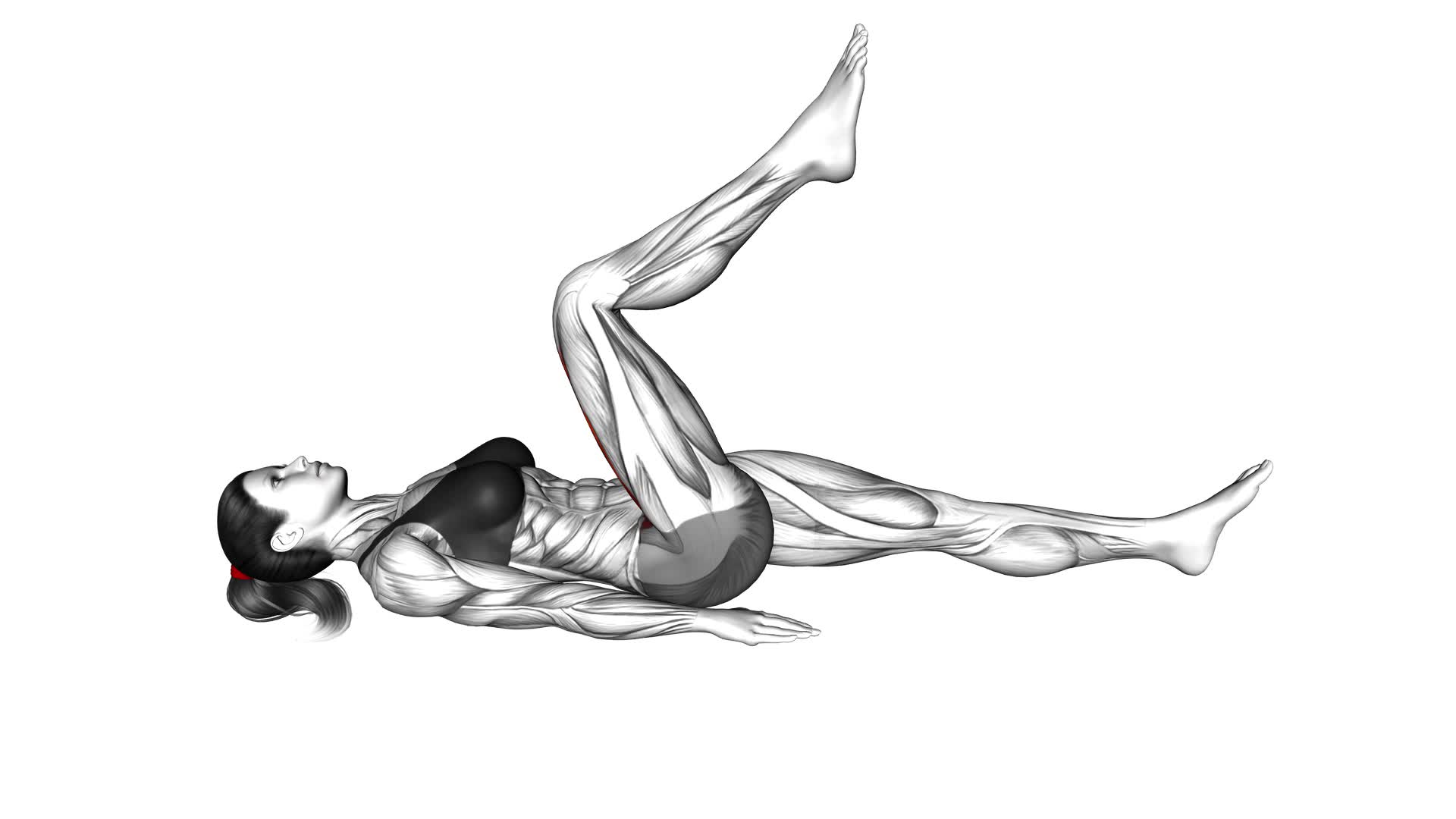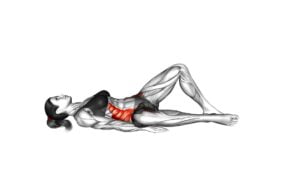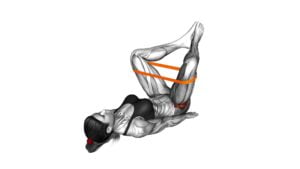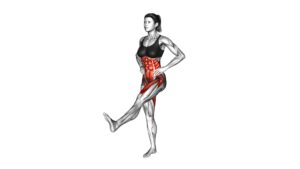Lying Hip Flexion With Knee Bent (Female) – Video Exercise Guide & Tips

Looking to strengthen your hip flexors? Try lying hip flexion with knee bent! This exercise targets the muscles in your hips and thighs, helping to improve flexibility and stability.
Watch This Exercise Video
In this video exercise guide, you'll learn the proper form and technique for performing lying hip flexion with knee bent. We'll also share common mistakes to avoid and provide variations and modifications to suit your fitness level.
So grab a mat and get ready to give your hip flexors a workout!
Key Takeaways
- Lying hip flexion with knee bent targets and strengthens hip flexor muscles for everyday movements like walking and running.
- The exercise engages core muscles, improving posture and stability.
- It increases flexibility of hip flexors, which is beneficial for individuals with tight hip muscles.
- Lying hip flexion with knee bent enhances lower body stability, prevents common injuries, and improves overall body alignment.
Benefits of Lying Hip Flexion With Knee Bent
- You'll experience three key benefits when performing the lying hip flexion with knee bent exercise.
First, this exercise targets and strengthens your hip flexor muscles, which are essential for everyday movements like walking, running, and climbing stairs. By improving the strength of these muscles, you can enhance your overall lower body stability and prevent common injuries.
Second, the lying hip flexion with knee bent exercise also engages your core muscles, specifically your abdominal muscles. This helps to improve your posture and stability, leading to better overall body alignment.
Lastly, this exercise can also help to increase the flexibility of your hip flexors, which can be beneficial for individuals who sit for long periods or have tight hip muscles.
Transitioning into the subsequent section about proper form and technique for lying hip flexion with knee bent, it's important to ensure you're performing the exercise correctly to maximize its benefits.
Proper Form and Technique for Lying Hip Flexion With Knee Bent
To perform the lying hip flexion with knee bent exercise correctly, you should maintain proper form and technique throughout the movement. This won't only ensure that you get the most out of the exercise, but also help prevent injuries and activate the targeted muscles effectively.
Here are some key tips to keep in mind:
- Keep your lower back pressed against the ground: This will help maintain proper spinal alignment and prevent any excessive arching that could strain the lower back.
- Engage your core muscles: By drawing your belly button in towards your spine, you can activate your core muscles and stabilize your pelvis throughout the movement.
- Squeeze your glutes at the top: When you lift your hips off the ground, make sure to squeeze your glute muscles at the top of the movement. This will enhance muscle activation and help you get the most out of the exercise.
Common Mistakes to Avoid During Lying Hip Flexion With Knee Bent
To avoid common mistakes during lying hip flexion with knee bent, it's important that you pay attention to your form and technique. One common mistake to avoid is improper alignment. Make sure to keep your hips stacked directly on top of each other and maintain a neutral spine throughout the exercise. This will prevent any unnecessary strain on your lower back.
Another mistake to avoid is relying solely on your hip flexor muscles to perform the movement. While the hip flexors are the primary muscles targeted in this exercise, it's important to engage your core muscles as well. This will help stabilize your pelvis and prevent any excessive arching in your lower back.
Additionally, be mindful of your knee position. Avoid letting your knee drift outward or inward during the movement. Keep it in line with your hip and ankle to ensure proper alignment and prevent any potential knee strain.
Lastly, avoid rushing through the exercise. Take your time and focus on the mind-muscle connection. This will allow you to fully engage and activate the targeted muscles, leading to better results and reducing the risk of injury.
Variations and Modifications for Lying Hip Flexion With Knee Bent
To modify the lying hip flexion with knee bent exercise, you can occasionally incorporate variations into your routine. This won't only add variety but also help you progress and challenge your muscles in different ways. Here are three variations that you can try:
- Single-leg lying hip flexion: Instead of lifting both legs together, try lifting one leg at a time while keeping the other leg extended on the ground. This variation will engage your core and glutes more intensely as you balance on one leg.
- Weighted lying hip flexion: To increase the intensity of the exercise, you can hold a dumbbell or a weighted plate on your hips while performing the movement. This will add resistance and further strengthen your hip flexors.
- Lying hip flexion with knee extension: Start with the basic lying hip flexion, but as you lift your leg, extend your knee fully before lowering it back down. This variation targets not only the hip flexors but also the quadriceps muscles.
Remember to start with the basic exercise and gradually incorporate these variations as you become more comfortable and stronger. Always listen to your body and choose the variations that suit your fitness level and goals.
Tips for Incorporating Lying Hip Flexion With Knee Bent Into Your Workout Routine
To incorporate lying hip flexion with knee bent into your workout routine, you can follow these tips for optimal results. Incorporating hip flexion exercises is a great way to target and strengthen your hip flexor muscles.
First, start by finding a comfortable surface to lie on, such as a yoga mat or exercise mat. This will provide support and cushioning for your back.
Next, make sure to maintain proper form throughout the exercise. Keep your core engaged and your lower back pressed into the mat. This will help to protect your spine and prevent any unnecessary strain.
When performing the exercise, focus on the movement of lifting your knee towards your chest while keeping your foot on the ground. This will engage your hip flexor muscles and help to increase their flexibility and strength.
Additionally, it's important to listen to your body and adjust the intensity of the exercise as needed. Start with a lower number of repetitions and gradually increase as you become more comfortable and stronger.
Remember to breathe throughout the exercise and avoid holding your breath. This will help to oxygenate your muscles and promote relaxation.
Frequently Asked Questions
Can Lying Hip Flexion With Knee Bent Help Improve Flexibility in Other Areas of the Body?
Lying hip flexion with knee bent can be beneficial for improving flexibility in other areas of your body. By targeting the hip flexors, this exercise helps to increase the range of motion in your hips, which can translate to improved flexibility in your legs and lower back.
Additionally, the engagement of your core muscles during this exercise can enhance overall core strength, providing stability and support for other movements and activities.
How Long Should I Hold the Position During Lying Hip Flexion With Knee Bent?
To improve balance and strengthen your hip muscles, it's important to hold the position during lying hip flexion with knee bent for the right amount of time. While the video exercise guide and tips can provide specific recommendations, a general guideline is to hold the position for about 10-30 seconds.
This duration allows your muscles to engage and work effectively. Remember to listen to your body and adjust the time as needed to challenge yourself while maintaining proper form.
Is Lying Hip Flexion With Knee Bent Suitable for People With Lower Back Pain?
Lying hip flexion with knee bent can be a suitable exercise for people with lower back pain. It helps strengthen the hip flexor muscles without putting excessive strain on the lower back.
However, it's important to consider other hip exercises as well. Alternatives such as glute bridges or clamshells can also target the hip muscles while providing relief for lower back pain.
Always consult with a healthcare professional before starting any exercise program, especially if you have existing back issues.
Can Lying Hip Flexion With Knee Bent Be Performed Without Any Equipment?
You can perform lying hip flexion with knee bent without any equipment. This exercise targets the hip flexors and can be modified to suit your needs.
Are There Any Precautions or Contraindications to Consider Before Attempting Lying Hip Flexion With Knee Bent?
Before attempting lying hip flexion with knee bent, it's important to consider some precautions and contraindications.
You should avoid this exercise if you have any hip or knee injuries or pain. It's also not recommended for individuals with conditions like arthritis or osteoporosis.
Make sure to consult with a healthcare professional before trying this exercise to ensure it's safe for you. Safety first!
Conclusion
Lying hip flexion with knee bent is an effective exercise for strengthening the hip flexor muscles. By maintaining proper form and technique, you can maximize the benefits of this exercise and avoid common mistakes.
There are also variations and modifications available to cater to different fitness levels and goals. Incorporating lying hip flexion with knee bent into your workout routine can help improve hip mobility and overall lower body strength.

Author
Years ago, the spark of my life’s passion ignited in my mind the moment I stepped into the local gym for the first time. The inaugural bead of perspiration, the initial endeavor, the very first surge of endorphins, and a sense of pride that washed over me post-workout marked the beginning of my deep-seated interest in strength sports, fitness, and sports nutrition. This very curiosity blossomed rapidly into a profound fascination, propelling me to earn a Master’s degree in Physical Education from the Academy of Physical Education in Krakow, followed by a Sports Manager diploma from the Jagiellonian University. My journey of growth led me to gain more specialized qualifications, such as being a certified personal trainer with a focus on sports dietetics, a lifeguard, and an instructor for wellness and corrective gymnastics. Theoretical knowledge paired seamlessly with practical experience, reinforcing my belief that the transformation of individuals under my guidance was also a reflection of my personal growth. This belief holds true even today. Each day, I strive to push the boundaries and explore new realms. These realms gently elevate me to greater heights. The unique combination of passion for my field and the continuous quest for growth fuels my drive to break new ground.







